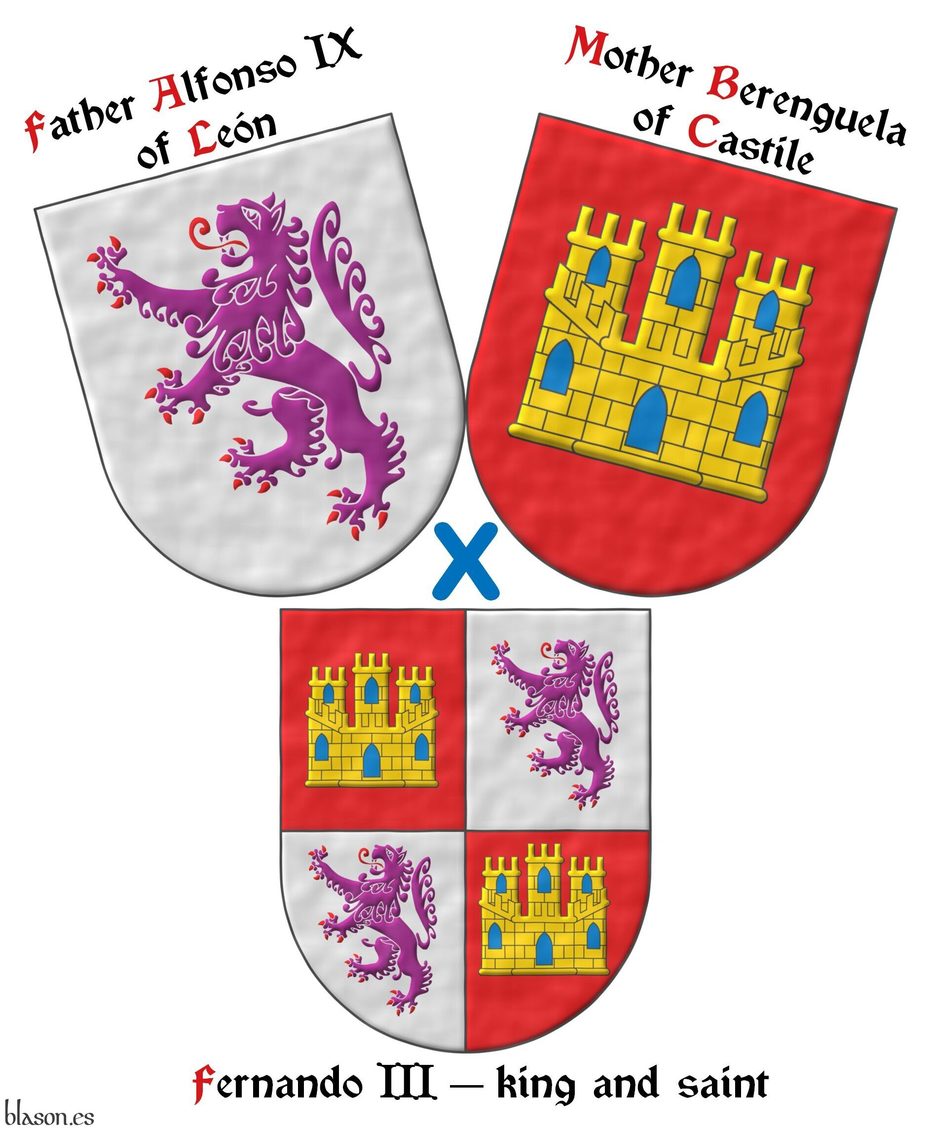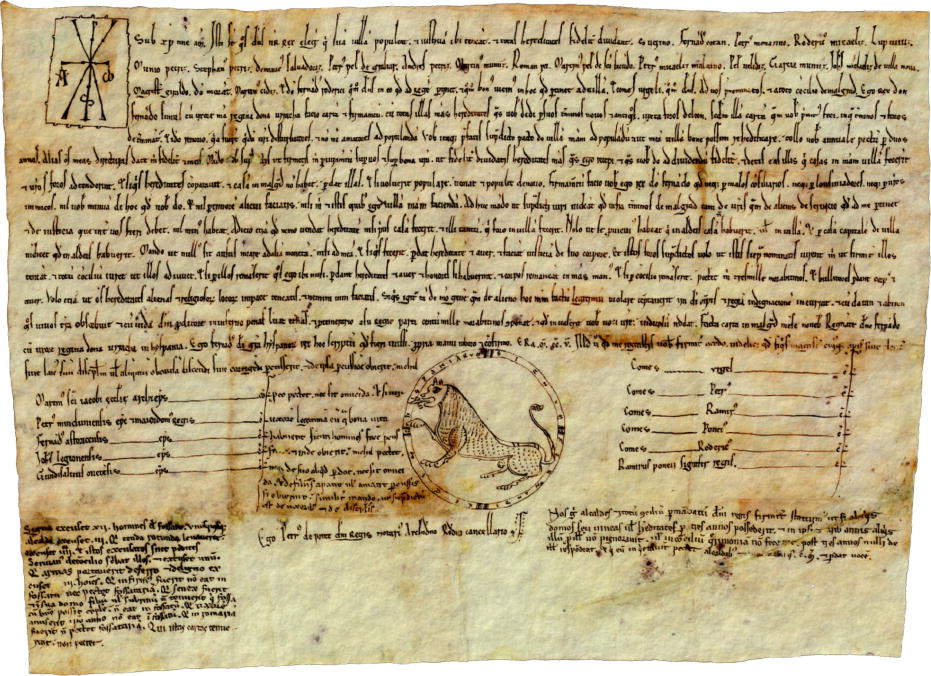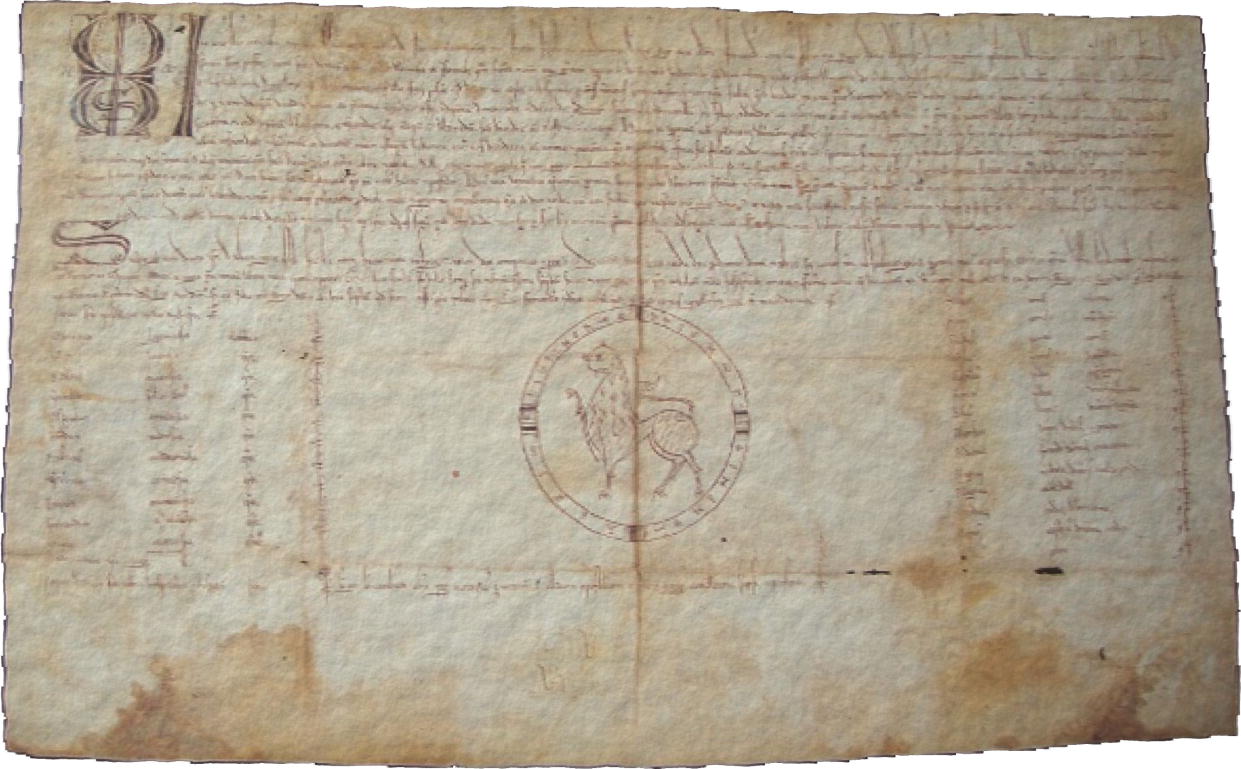Kingdom of León


Alfonso IX of Leon

Born on August 15, 1171, in Zamora and died on September 24, 1230, in Sarria, Lugo.
Argent, a lion rampant Purpure, armed and langued Gules.
Escudo de plata, un león rampante de púrpura, armado y lampasado de gules.
Arms of the king of León interpreted by me as follows: the escutcheon is in a semi-circular arch; the field and the lion have been enameled and illuminated; and the ensemble has a watercolor finish.
This coat of arms of León can be seen, among many other places, for example, in [Argote de Molina, G.; 1588; chapter XLII].
Blazon keywords: Without divisions, Argent, Purpure, Gules, One, Lion, Rampant, Armed and Langued.
Style keywords: Semi-circular, Illuminated, Outlined in the field tincture and Watercolor.
Classification: Interpreted, Personal, Coat of arms and Kingdom of León.
Bearer: Alfonso IX of Leon.


Alfonso IX of Leon, open royal crown
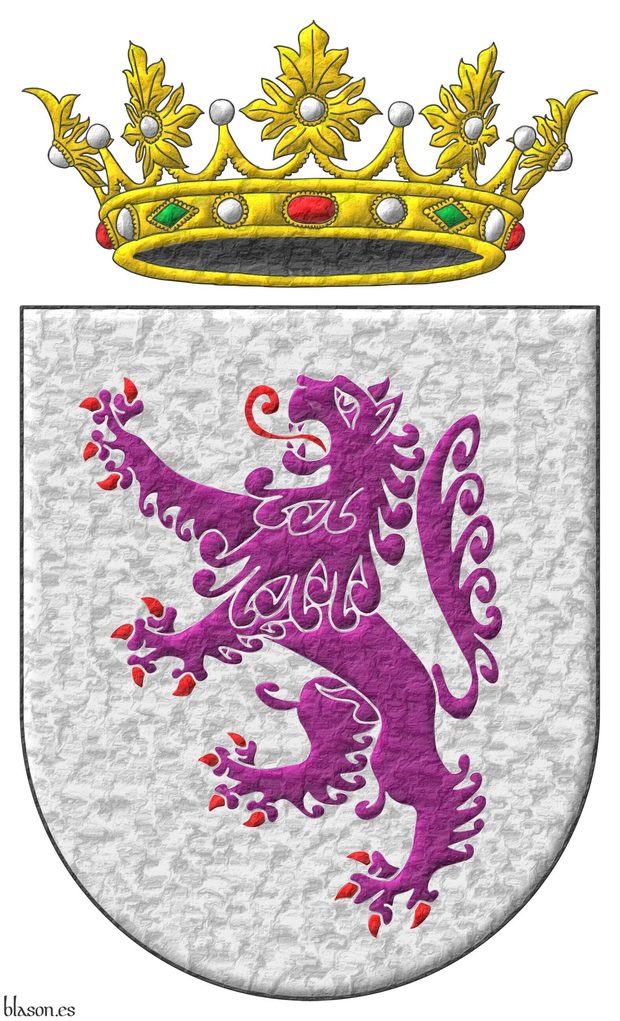
King of León from January 21, 1188, until his death on September 24, 1230.
Argent, a lion rampant Purpure, armed and langued Gules. Crest: An open royal crown Or.
Escudo de plata, un león rampante de púrpura, armado y lampasado de gules. Timbrado de una corona real abierta.
Arms of the King interpreted as follows: the escutcheon is finished in a semi-circular arch; both the field, the lion, and the crown of the crest have been illuminated; and the ensemble has a hammered metal finish.
Purple lion of the Kingdom of León
In the following image, I show a miniature from the Tumbo A of the Cathedral of Santiago de Compostela, from the 13th century, with the heading reading «Inclitus:Adeffonsus:Rex:Legionensium:et Gallecie:», combined with my interpretation of his coat of arms. The lion of the Kingdom of León can be found depicted in both purple and gules, but images like this confirm that it is purple, and I particularly favor the purple, as it makes it historically unique.
Blazon keywords: Without divisions, Argent, Purpure, Gules, One, Lion, Rampant, Armed, Langued, Crest, Open royal crown and Crown.
Style keywords: Semi-circular, Illuminated and Metal beaten.
Classification: Interpreted, Personal, Coat of arms and Kingdom of León.
Bearer: Alfonso IX of Leon.


Berenguela of Castile and Alfonso IX
[ Argent, a lion rampant Purpure, armed and langued Gules ] accolé with [ Gules, a castle triple towered Or, port and windows Azure, masoned Sable ].
[ Escudo de plata, un león rampante de púrpura, armado y lampasado de gules ] acolado de un [ escudo de gules, un castillo de oro, aclarado de azur, mazonado de sable ].
Arms of the King of Leon and Queen of Castile, as interpreted by me with: the two shields shaped with rounded arches; the fields of both coat of arms, the lion, and the castle illuminated; and the whole composition featuring a watercolor finish.
Representation of the coats of arms of Alfonso IX of León and Berenguela of Castile as accolé arms ~ «escudos acolados». King Ferdinand III created his coat of arms, based on the coats of arms of his parents, through the marshalling of their arms ~ «composición de sus armas». For this purpose, the saintly king invented a type of composition, which later became widely used, known as quarterly ~ «cuartelado». Other ways to combine the coats of arms of two spouses are:
- Creating a new dimidiated shield ~ «dimidiado».
- Creating a new impaled shield ~ «partido».
- Adding one coat of arms to another as an escutcheon of pretence ~ «escusón de pretensión», in this case, rather than a claim, there was full ownership.
Blazon keywords: Without divisions, Argent, Purpure, Gules, One, Lion, Rampant, Armed, Langued, Or, Azure, Sable, Castle, Port and windows and Masoned.
Style keywords: Semi-circular, Outlined in sable, Tilted shield and Watercolor.
Classification: Interpreted, Personal, Accolé arms, Kingdom of Castile and Kingdom of León.
Bearer: Berenguela of Castile.


Ferdinand II of Leon
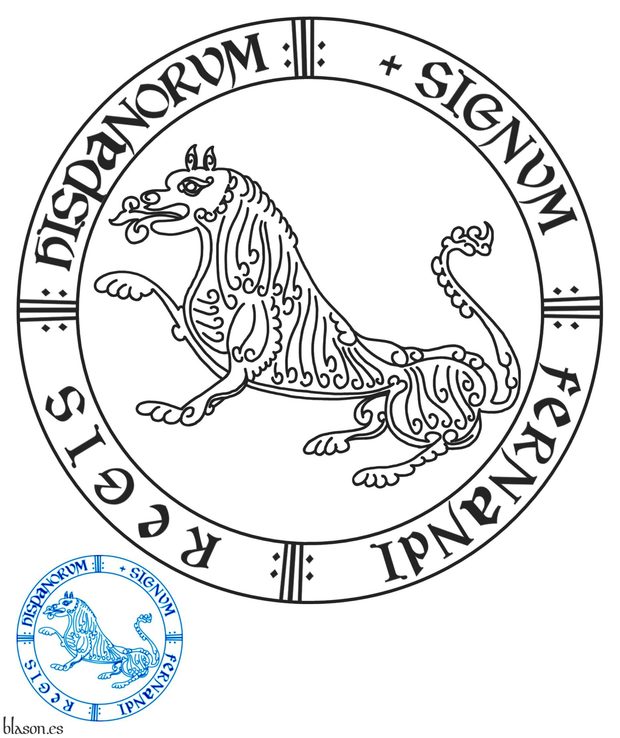
Round seal, a lion sejant. Circular motto: «Signum Fernandi Regis Hispanorum».
Sello rodado, un león sentado. Divisa circular: «Signum Fernandi Regis Hispanorum».
Existing seal interpreted by me as follows: the shape of the seal is circular; the motto is written in sable on its outer ring; inside, a seated lion that begins to be rampant and will eventually become so; y the whole rendered in flat sable ink; y the result is an impression in azure ink.
For the outline of the lion I have followed the round seal of the king in his «Charter of Benavente» [Fernando II de León; 1167], in which I consider the lion to be seated; although it could also be interpreted as rampant, or as intending to be so, as it will ultimately appear in the arms of his son, King Alfonso IX of León.
For the delineation of the motto I have followed the round seal of the king in his «Charter of the Alfoz of Benavente» [Fernando II de León; 1181], in which the lion, unlike the previous one, is clearly in a passant posture.
In [Martín Fuertes, J. A.; 2002] four other round seals of King Fernando II of León can be consulted:
- from the year 1160 (A.C. de León, number 4168) with a lion passant,
- from the year 1165 (A.C. de León, number 1041) with another lion passant,
- from the year 1168 (A.C. de León, number 170) with a lion statant, also described as arrested or at rest, as mentioned in [Avilés, J.; 1725a; page 37] and [Avilés, J.; 1780a; page 42].
- from the year 1187 (A.C. de León, number 1067) with a lion passant and regardant, that is, with its head turned toward the sinister side of the round seal, a posture described, for example, in [Avilés, J.; 1725a; page 55] and [Avilés, J.; 1780a; page 61].
In attitudes of the lion of Ferdinand II the attitudes discussed in this article are illustrated.
Blazon keywords: Without divisions, One, Lion, Sejant and Motto (identification).
Style keywords: Round, Plain tincture and Sealed.
Classification: Interpreted, Personal, Seal and Kingdom of León.
Bearer: Ferdinand II of Leon.


Ferdinand II, imaginary coat of arms

Argent, a lion sejant erect Purpure.
Escudo de plata, un león sentado de púrpura.
Imaginary coat of arms of King Fernando II of León, which I have developed based on his seal and the arms of his successor, with: the shape of the coat of arms is semi-circular; the field enameled in flat argent; the lion enameled in purpure and illuminated; and the whole rendered with a watercolor finish.
For this imaginary coat of arms I have chosen a representation of the lion in a posture similar to that of the great seal appearing in [Fernando II de León; 1167], which is sejant ~ «sentado» in Castilian, although beginning to rise «sejant erect».
It should be noted that we are in a pre-heraldic period where the possible attitudes of the lion were not yet clearly defined, although several of them are already anticipated in the great seals of Fernando II, as can be seen, for example, passant in [Fernando II de León; 1181] and in other attitudes in the photographs of [Martín Fuertes, J. A.; 2002].
Blazon keywords: Without divisions, Argent, Lion, Purpure and Sejant.
Style keywords: Semi-circular, Illuminated, Outlined in the field tincture and Watercolor.
Classification: Interpreted, Imaginary, Coat of arms and Kingdom of León.
Imaginary bearer: Ferdinand II of Leon.


Ferdinand III, invention of quartering
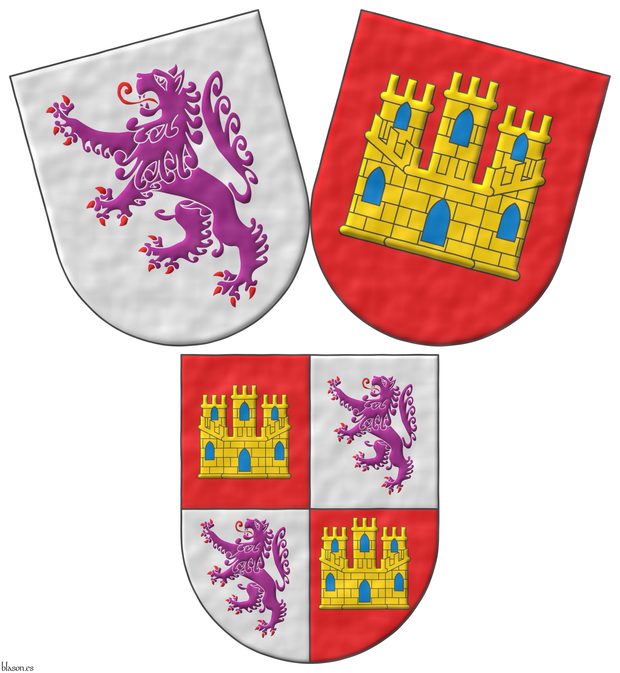
Quarterly: 1 and 4 Gules, a castle triple towered Or, port and windows Azure, masoned Sable; 2 and 3 Argent, a lion rampant Purpure, armed and langued Gules.
Escudo cuartelado: 1o y 4o de gules, un castillo de oro, aclarado de azur, mazonado de sable; 2o y 3o de plata, un león rampante de púrpura, armado y lampasado de gules.
A symbolic image representing, through 3 coats of arms, the creation of the coat of arms of the King Ferdinand III the Saint from the arms of Alfonso IX, King of León, and Berenguela, Queen of Castile. The shapes of all three shields are rounded; all their components are illuminated; and the whole composition features a watercolor finish.
Ferdinand III the Saint was the son of Alfonso IX of León and Berenguela of Castile. During his reign, the crowns of Castile and León were united forever. When, in 1230, Ferdinand III succeeded his father, he adopted a quarterly coat of arms, placing his mother's arms, the castle, in the 1st and 4th quarters, and his father's arms, the lion, in the 2nd and 3rd quarters. His goal was likely to achieve balance between the two kingdoms and to give his coat of arms a greater sense of continuity over time compared to impaled arms. The coat of arms of Ferdinand III the Saint was the first quarterly shield in history, and the idea spread into the heraldry of Spain and other kingdoms, such as Aragon-Sicily, Brabant, England, Navarre, and Bohemia.
The mother first, schematic in English
Blazon keywords: Quarterly, Gules, Or, Azure, Sable, One, Castle, Port and windows, Masoned, Argent, Purpure, Lion, Rampant, Armed, Langued, Crest, Open royal crown and Crown.
Style keywords: Semi-circular, Illuminated, Tilted shield and Watercolor.
Classification: Interpreted, Personal, Accolé arms, Family tree, Genealogical, Kingdom of Castile, Kingdom of León and Kingdom of Castile and Leon.
Bearer: Ferdinand III of Castile.


![Ver [Fernando II de León; 1167] en referencias bibliográficas. Libro abierto, hojas de plata, filo de oro, guardas de gules, tapas de sable.](../css/Libro.Bibliografia.png)
Fernando II de León; 1167

Fernando II, King of León, «Carta Puebla de Benavente», Historical Archive of the City Council of Benavente, dated November 1167.
It is a document in which King Fernando II of León grants privileges to Benavente with the aim of repopulating this town.
The original document is a parchment measuring 60 x 43 centimeters, adorned in the upper right corner, right according to the heraldic criterion, with a Chi Rho from which hang an alpha and an omega. In what could be considered the navel of the charter is a rolled seal of the king formed by a lion, which I consider closer to rampant than passant, surrounded by a circular motto that reads «Signum Fernandi Regis Hispanorum» ~ «Sign of Fernando, King of the Spains». Additionally, this rolled seal is accompanied by the names of members of the chancery and prelates of the Kingdom of León, to confirm the grants recorded in the «Carta Puebla de Benavente».
This charter, also called the «Fuero de Benavente», is a beautiful example of local law and, since its promulgation in 1167, served as a model for other towns. In the following years, similar charters to that of Benavente were adopted in other towns of León, Asturias, and Galicia, with the one in La Coruña being a notable example.
The objective of the provisions of this charter was to favor the repopulation and settlement of new settlers in the town of Benavente, and its successful operation in this aspect led to its application in other places.
The original document is kept in the Municipal Archive of Benavente, forming part of its collection of royal privileges of Benavente. There is also a «facsimile» edition, like the one that illustrates this bibliographic reference, published in 2002 by the Benavente City Council on the occasion of the Commemoration of the VIII Centenary of the Benavente Courts.
Bibliographical reference of century XII.
Author: Fernando II de León.
Bibliographic reference mentioned in the following articles:
External resources:
- Benavente remembers Fernando II of León.
- Churches in the parish of Renueva.
- Facsimile of the Carta Puebla de Benavente.
- Carta Puebla in PDF.
Internal resources: FernandoII.24.Facsimil.CartaPueblaBenavente.pdf in armorial, Fernando II of León, key 104..


![Ver [Fernando II de León; 1181] en referencias bibliográficas. Libro abierto, hojas de plata, filo de oro, guardas de gules, tapas de sable.](../css/Libro.Bibliografia.png)
Fernando II de León; 1181
Fernando II, King of León, «Privilegio de Ampliación del Alfoz de Benavente», Historical Archive of the City Council of Benavente, 1181.
Bibliographical reference of century XII.
Author: Fernando II de León.
The following articles cite this bibliographic reference:
External link:
-
Language
-
Categories of heraldry
-
Divisions of the field
- Without divisions
- Party per pale
- Party per fess
- Party per bend
- Party per bend sinister
- Tierce
- Tierce sinister
- Tierced per pale
- Tierced per fess
- Tierced per bend
- Tierced pallwise inverted
- Quarterly
- Quarterly per saltire
- Gyronny
- Party per fess, the chief per pale
- Party per pale, the sinister per fess
- Party per fess, the base per pale
- Party per pale, the dexter per fess
- Chapé
- Chaussé
- Embrassé
- Contre-embrassé
- Party per chevron
- Enté
- Enté en point
- Flanched
-
Metals
-
Colours
-
Furs
-
Other tinctures
-
Ordinaries and sub-ordinaries
-
Diminutives of the ordinaries
-
Geometric charges
-
Composite ordinaries
-
Inanimate charges from Nature
Atom, Crescent, Diamond, Emerald, Estoile, Increscent, Lightning flash, Moon, Mount, Mullet, Mullet of four points, Orbital, Plough of Ursa Major, Rainbow, Ray of the sun, River, Sea, Snowflake, Sun, Sun in splendour, Sun of May, Trimount, Water and Wave.
-
Vegetal charges from Nature
Acorn, Apple, Apple tree, Ash, Bluebonnet, Camellia, Chrysanthemum, Cinquefoil, Cornflower, Dogwood flower, Double rose, Elm, Fleur de lis, Flower, Gourd, Holm oak, Hop cone, Kapok tree, Laurel, Lily, Linden, Lotus flower, Madonna lily, Mexican cedar tree, Oak, Olive tree, Palm tree, Plantain plant, Pomegranate, Poplar leaf, Rose, Shamrock, Sunflower, Thistle, Tree, Tulip, Vine and Wheat.
-
Animal charges from Nature
Badger, Bald eagle, Barbel, Barn owl, Bear, Beaver, Beetle, Bighorn sheep, Blackbird, Boar, Brach hound, Bull, Doe, Dog, Dolphin, Dove, Eagle, Elephant, Falcon, Female figure, Fish, Flame, Fly, Fox, Frog, Goat, Goldfinch, Goose, Heron, Horse, Hummingbird, Jaguar, Lark, Leopard, Lion, Lion passant, Lion rampant guardant, Lioness, Lynx, Male figure, Martlet, Merino ram, Owl, Panther, Parrot, Peacock, Pelican, Pelican in her piety, Puffin, Quetzal, Raven, Roe deer, Rooster, Savage, Seagull, Serpent, She-wolf, Stag, Starling, Talbot, Tyger, Vulture, Warren hound and Wolf.
-
Parts of natural charges
Arm, Beak, Branch, Caboshed, Chest, Claw, Covert, Dorsal fin, Eagle claw, Ermine spot, Escallop, Feather, Foot (palmiped), Foreleg, Forepaw, Hand, Head, Heart, Hoof, Leaf, Neck, Ostrich feather, Palm frond, Paw, Roe deers' attires, Shoulder, Sprig, Stags' attires, Stem, Swallow-tail, Tail, Tail addorsed, Tail fin, Talon, Tooth, Trunk, Trunk (elephant), Two hands clasped, Two wings in vol, Udder, Wheat spike, Wing and Wrist.
-
Artificial charges
Ace of spades, Anchor, Anvil, Arch, Arm vambraced, Armillary sphere, Arrow, Axe, Bell, Bell tower, Beret, Bonfire, Book, Bookmark, Bow, Branding iron, Bridge, Broken, Buckle, Cannon, Cannon dismounted, Cannon port, Canopy roof, Carbuncle, Castle, Celtic Trinity knot, Chain, Chess rooks, Church, Clarion, Clay pot, Closed book, Club, Column, Comb, Compass rose, Conductor's baton, Cord, Covered cup, Crozier, Crucible, Cuffed, Cup, Cyclamor, Dagger, Double vajra, Drum, Ecclesiastical cap, Fanon, Federschwert, Fleam, Four crescents joined millsailwise, Galician granary, Garb, Gauntlet, Geometric solid, Grenade, Halberd, Hammer, Harp, Host, Hourglass, Key, Key ward, Knight, Knot, Lantern, Letter, Line, Loincloth, Menorah, Millrind, Millstone, Millwheel, Monstrance, Mortar, Mullet of six points pierced, Nail, Non-classic artifact, Norman ship, Number, Oar, Oil lamp, Open book, Page, Pair of scales, Parchment, Pestle, Piano, Pilgrim's staff, Plough share, Polish winged hussar, Port, Portcullis, Potent, Quill, Ribbon, Rosette of acanthus leaves, Sabre, Sackbut, Sail, Scroll, Scythe, Sheaf of tobacco, Ship, Skirt, Spear, Spear's head, Stairway, Star of David, Step, Sword, Symbol, Tetrahedron, Torch, Tower, Trident, Trumpet, Turret, Two-handed sword, Wagon-wheel, Water-bouget, Wheel, Winnowing fan and With a turret.
-
Immaterial charges
Angel, Archangel, Basilisk, Dragon, Dragon's head, Garuda, Golden fleece, Griffin, Heart enflamed, Justice, Mermaid, Our Lady of Mercy, Ouroboros, Paschal lamb, Pegasus, Phoenix, Sacred Heart of Jesus, Saint George, Sea-griffin, Trinity, Triton, Unicorn, Winged hand and Wyvern.
-
External elements
-
Heraldic creations
-
References
-
Formats
-
Keywords on this page
Port and windows, Watercolor, Alfonso IX of Leon, Armed, Azure, Berenguela of Castile, Bibliography, Castle, Crest, Round, Crown, Open royal crown, Quarterly, Outlined in sable, Outlined in the field tincture, Motto (identification), Coat of arms, Accolé arms, Sealed, Ferdinand II of Leon, Ferdinand III of Castile, Genealogical, Personal, Gules, Illuminated, Imaginary, Interpreted, Langued, Lion, Masoned, Semi-circular, Metal beaten, Or, Argent, Without divisions, Purpure, Rampant, Kingdom of Castile, Kingdom of Castile and Leon, Kingdom of León, Tilted shield, Sable, Seal, Sejant, Century XII, Plain tincture, One and Family tree.

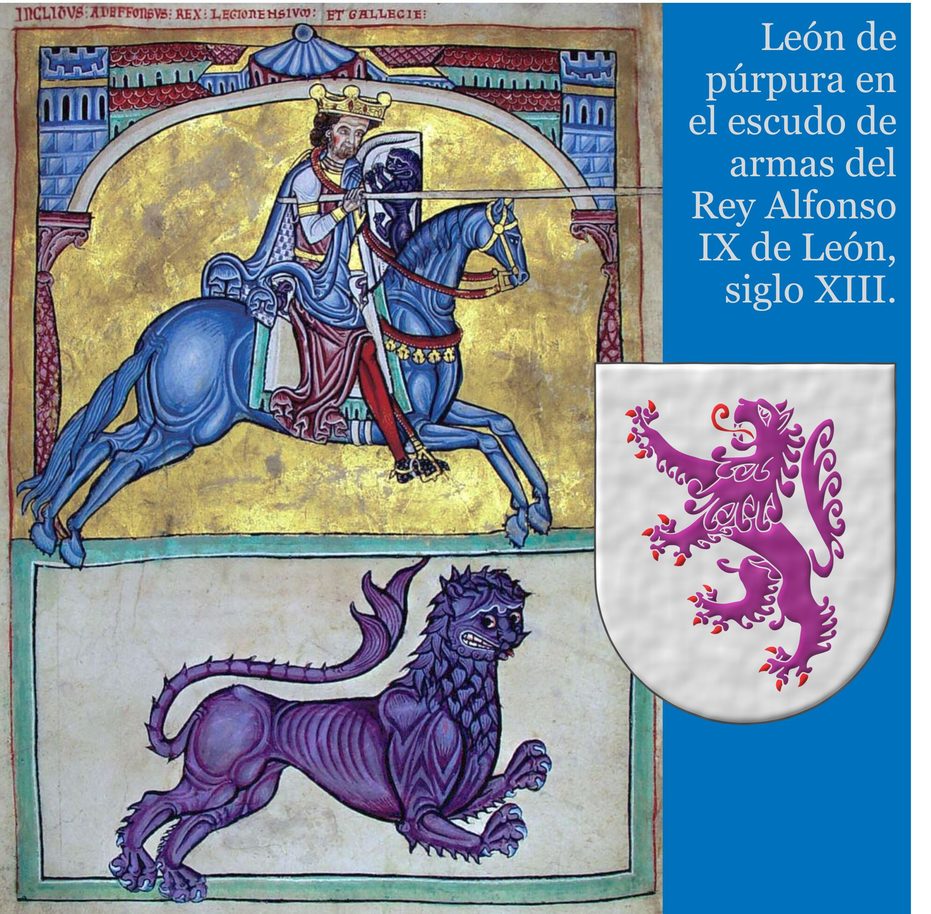
![Berenguela of Castile and Alfonso IX [ Argent, a lion rampant Purpure, armed and langued Gules ] accolé with [ Gules, a castle triple towered Or, port and windows Azure, masoned Sable ].](../escudo_armas/BerenguelaC.23.Matrimonio.jpg)
